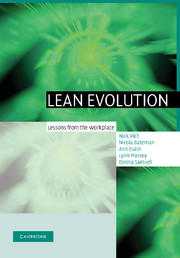Book contents
- Frontmatter
- Contents
- List of boxes
- List of figures
- List of tables
- Glossary
- 1 Introduction
- 2 Understanding the lean journey
- 3 Understanding your organisation
- 4 Laying the foundation stone of CANDO
- 5 Visual management and performance measurement
- 6 Problem solving, TQM and Six Sigma
- 7 Pull systems
- 8 Total productive manufacturing (TPM)
- 9 Sustainability
- 10 Group learning
- 11 Reflections and future challenges
- References
- Index
1 - Introduction
Published online by Cambridge University Press: 17 August 2009
- Frontmatter
- Contents
- List of boxes
- List of figures
- List of tables
- Glossary
- 1 Introduction
- 2 Understanding the lean journey
- 3 Understanding your organisation
- 4 Laying the foundation stone of CANDO
- 5 Visual management and performance measurement
- 6 Problem solving, TQM and Six Sigma
- 7 Pull systems
- 8 Total productive manufacturing (TPM)
- 9 Sustainability
- 10 Group learning
- 11 Reflections and future challenges
- References
- Index
Summary
I'd like to do some improvement work, but I'm always too busy.
If this sounds familiar to you, then you are the person for whom this book has been written. Continually displacing what is important for what is urgent is endemic amongst western managers. We call it the ‘fire-fighting syndrome’, because we have an image of a manager with a fire hose who spends his time fending off the problems of the day. The trouble is, of course, if we never make time for what we know to be important, we may not have a business tomorrow!
This book addresses the messy subject of lean implementation. If you are involved in business improvement and have figured out that it is one thing to find out what to do but another to actually do it, then this book has been written with you in mind.
Let us address the meaning of lean first of all. If you are familiar with the car industry or even the manufacturing sector more widely, then you may have come across the term. The term ‘lean’, coined by a group of academics, concerns the ability of the Toyota Motor Corporation to achieve outstanding manufacturing performance levels in Japan. They wanted a word to capture what they saw – a system without ‘fat’. By fat we really mean waste and we'll come back to that later on.
- Type
- Chapter
- Information
- Lean EvolutionLessons from the Workplace, pp. 1 - 10Publisher: Cambridge University PressPrint publication year: 2006
- 2
- Cited by



